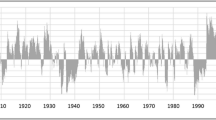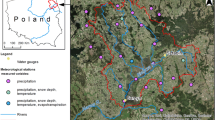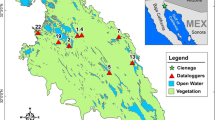Abstract
The natural Australian landscape sustains a mosaic of wetlands that range from permanently wet to temporary. This diversity of wetland types and habitats provides for diverse biotic communities, many of which are specific to individual wetlands. This paper explores the prospects for southern Australian wetlands under modified water regime and salinity induced by climatic changes. Extended droughts predicted as a consequence of climate change (lower rainfall and higher temperatures) combined with human-induced changes to the natural hydrological regime will lead to reductions in the amount of water available for environmental and anthropogenic uses. Reduced runoff and river flows may cause the loss of some temporary wetland types that will no longer hold water long enough to support hydric communities. Species distributions will shift and species extinctions may result particularly across fragmented or vulnerable landscapes. Accumulation of salts in wetlands shift species-rich freshwater communities to species-poor salt tolerant communities. Wetlands will differ in ecological response to these changes as the salinity and drying history of each wetland will determine its resilience: in the short term some freshwater communities may recover but they are unlikely to survive and reproduce under long term increased salinity and altered hydrology. In the long term such salinized wetlands with altered hydrology will need to be colonized by salt tolerant species adapted for the new hydrological conditions if they are to persist as functional wetlands. As the landscape becomes more developed, to accommodate the need for water in a warmer drying climate, increasing human intervention will result in a net loss of wetlands and wetland diversity.
Similar content being viewed by others
References
Baldwin D (1996) Salinity in inland rivers. Australas Sci 17:15–17
Bond NR, Lake PS, Arthington AH (2008) The impacts of drought on freshwater ecosystems: an Australian perspective. Hydrobiologia 600:3–16
Boulton AJ, Brock MA (1999) Australian freshwater ecology: processes and management. Gleneagles, Glen Osmond
Bowler JM (1981) Australian salt lakes a paleohydrologic approach. Hydrobiologia 82:431–444
Brock MA (1986) Adaptations to fluctuations rather than to extremes of environmental parameters. In: De Deckker P, Williams WD (eds) Limnology in Australia. CSIRO/Junk, Melbourne/Dordecht
Brock MA, Jarman PJ (2000) Wetland use and conservation in the agricultural environment: managing processes for the components. In: Craig JL, Mitchell N, Saunders DA (eds) Nature conservation 5: nature conservation in production environments: managing the matrix. Surrey Beatty, Chipping Norton
Brock MA, Lane JAK (1983) The aquatic macrophyte flora of saline wetlands in Western Australia in relation to salinity and permanence. Hydrobiologia 105:63–76
Brock MA, Shiel RJ (1983) The composition of aquatic communities in saline wetlands in Western Australia. Hydrobiologia 105:77–84
Brock MA, Smith RGB, Jarman PJ (1999) Drain it, dam it: alteration of water regime in shallow wetlands on the New England Tableland of New South Wales, Australia. Wetlands Ecol Manag 7:37–46
Brock MA, Nielsen DL, Shiel RJ, Green JD, Langley JD (2003) Drought and aquatic community resilience: the role of eggs and seeds in sediments of temporary wetlands. Freshw Biol 48:1207–1218
Brock MA, Nielsen DL, Crosslé K (2005) Changes in biotic communities developing from freshwater wetland sediments under experimental salinity and water regimes. Freshw Biol 50:1376–1390
Dalal RC, Allen DE (2008) Turner review no. 18. Greenhouse gas fluxes from natural ecosystems. Aust J Bot 56:369–407
Dunlop M, Brown PR (2008) Implication of climate change for Australia’s national reserve system: a preliminary assessment. CSIRO Sustainable Ecosystems report to the Department of Climate Change and the Department of the Environment, Water, Heritage and the Arts, Canberra
Green J, Mengestou S (1991) Specific diversity and community structure of Rotifera in a salinity series of Ethiopian inland waters. Hydrobiologia 209:95–106
Froend RHE, Heddle M, Bell DT, McComb AJ (1987) Effects of salinity and waterlogging on the vegetation of Lake Toolibin, Western Australia. Aust J Ecol 12:281–298
Halse SA, Shiel RJ, Williams WD (1998) Aquatic invertebrates of Lake Gregory, northwestern Australia, in relation to salinity and ionic composition. Hydrobiologia 381:15–29
Hammer UT (1986) Saline lake ecosystems of the world. Junk, Dordrecht
Hart BT, Bailey P, Edwards R, Hortle K, James K, McMahon A, Meredith C, Swadling K (1991) A review of the salt sensitivity of the Australian freshwater biota. Hydrobiologia 210:105–144
Jacobs SWL, Brock MA (1993) Wetlands of Australia: Southern temperate Australia. In: Whigham DF, Dykyjova D, Hejny S (eds) Wetlands of the World I: inventory, ecology and management. Kluwer, The Netherlands
James K, Cant B, Ryan T (2003) Responses of freshwater biota to rising salinity levels and implications for saline water management: a review. Aust J Bot 51:703–713
Jones RN, McMahon TA, Bowler JM (2001) Modelling historical lake levels and recent climate change at three closed lakes, Western Victoria, Australia (c. 1840–1990). J Hydrol 246:159–180
Jones RN, Whetton P, Walsh K, Page C (2002) Future impact of climate variability, climate change and land use change on water resources in the Murray–Darling Basin. Overview and draft program of research. CSIRO Atmospheric Research, Aspendale
Kingsford RT, Porter JL (1994) Waterbirds on an adjacent freshwater lake and salt lake in arid Australia. Biol Conserv 69:19–228
Lake PS (2008) Drought, the “creeping disaster”. Effects on aquatic ecosystems. Land and Water Australia, Canberra
Linacre E, Hobbs J (1977) The Australian climatic environment. Wiley, Brisbane Australia
Macumber PG (1991) Interaction between groundwater and surface systems in northern Victoria. Department of Conservation and Environment, Victoria
Makarewicz J, Likens GE (1975) Niche analysis of a zooplankton community. Science 190:1000–1003
Natural Resource Management Ministerial Council (2004) National biodiversity and climate change action plan 2004–2007. Australian Government, Department of the Environment and Heritage, Canberra, ACT
Nielsen DL, Brock MA, Crosslé K, Harris M, Healey M, Jarosinski I (2003a) The effects of salinity on aquatic plant germination and zooplankton hatching from two wetland sediments. Freshw Biol 48:2214–2223
Nielsen DL, Brock MA, Rees GN, Baldwin DS (2003b) Effects of increasing salinity on freshwater ecosystems in Australia. Aust J Bot 51:655–665
Nielsen DL, Brock MA, Petrie R, Crosslé K (2007) The impact of salinity pulses on the emergence of plant and zooplankton from wetland seed and egg banks. Freshw Biol 52:784–795
Nielsen DL, Brock MA, Vogel M, Petrie R (2008) From fresh to saline: a comparison of zooplankton and plant communities developing under a gradient of salinity with communities developing under constant salinity levels. Mar Freshw Res 59:549–559
Pittock B (2003) Climate change: an Australian guide to the science and impacts. Australian Green House Office, Canberra
Savage AA (1979) The Corixidae of an inland saline lake from 1970 to 1975. Arch Hydrobiol 86:355–370
Shiel RJ, Green JD, Nielsen DL (1998) Floodplain biodiversity: why are there so many species? Hydrobiologia 387/388:39–46
Smith 2006 (2006) Can dormant eggs survive under elevated salinity. MDFRC report, Wodonga
Timms BV (1993) Saline lakes of the Paroo, inland New South Wales, Australia. Hydrobiologia 267:269–289
Torgersen T, De Deckker P, Chivas AR, Bowler JM (1986) Salt lakes: a discussion of processes influencing palaeoenvironmental interpretation and recommendations for future study. Palaeogeogr Palaeoclimatol Palaeoecol 54:7–19
Walker KF, Thoms MC (1993) Environmental effects of flow regulation on the lower Murray River, Australia. Regul River 8:103–119
Williams WD (1987) Salinisation of rivers and streams: an important environmental hazard. Ambio 16:180–185
Williams WD (1998) Salinity as a determinant of the structure of biological communities in salt lakes. Hydrobiologia 381:191–201
Author information
Authors and Affiliations
Corresponding author
Rights and permissions
About this article
Cite this article
Nielsen, D.L., Brock, M.A. Modified water regime and salinity as a consequence of climate change: prospects for wetlands of Southern Australia. Climatic Change 95, 523–533 (2009). https://doi.org/10.1007/s10584-009-9564-8
Received:
Accepted:
Published:
Issue Date:
DOI: https://doi.org/10.1007/s10584-009-9564-8




